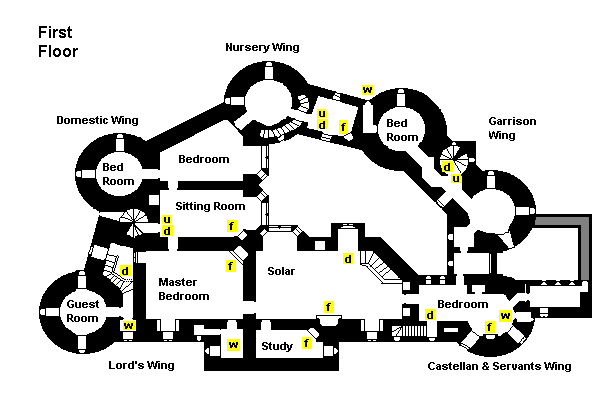|
Appendix I
Gelling Castle, Farnish

The inner ward is on the site of a small Iron-Age hill fort that was refortified by the Welsh in the Dark Ages as a protection against Irish raiders. There is a very large, but weakly defended, outer ward, along the outer embankment of the fort, and to the south of the river the extensive home farm which is over 400 acres in extent and takes up the southwest corner of Borwood. It took nearly 70 years to complete the castle, as resources in the area were rather limited, but it was 'high-tech' for its time, resembling Edward I's Conway Castle with its round towers. The last Gellinge was attainted for treason by Henry VIII, and the estate given to a nephew of Thomas Cromwell, who rebuilt the interior as a Tudor manor house. Little was done to the castle after that time, although it continued to function as a rural retreat, as it were. The later Cromwell did not even bother with it, although he did heavy damage to the castle in Farnisham. It fell into decay after the family lost its fortune in the South Sea Bubble and was not reconstructed until Gilbert Sullivan bought it in 1931. |
Located a mile and a half east of Gelling, and sited on a rocky hill in a bend of the River Gelling, this small but many-towered castle was built by Sir John de Gellinge in 1263. He was an illegitimate son of Henry III who was made Baron of West Farnish (provided he stayed out of England). It fell into ruin in the 18th century, but was restored by the famous painter Gilbert Sullivan in the 1930s as a summer retreat. It contains the largest collection of his paintings in the world, although they are no longer fashionable. Still lived in by his descendents, the castle is not open to the public except on special occasions and bank holidays. The Sullivan family are extensive in this part of Farnish and are considered to be the local gentry and prime employers. |

Embedded in the rock, the cellars and chambers of Gelling Castle are connected by an unusual (Tudor-period) system of tunnels beneath the courtyard. The prison probably really was one, but Gilbert Sullivan fitted it out as a torture room/dungeon for his children to play in. The well is 150 feet deep. A small postern leads to a hidden path down to the river.

Access to the Gatehouse is through a small courtyard in the Barbican, with a drawbridge spanning a pit before the main gate and a guardroom on the south side. The Garrison and Kitchen blocks were used by the lord's retainers; the castellan lived in the gatehouse above the kitchen. Most of Sullivan's art collection is housed in the garrison block's ground floor. A grassy courtyard faces the L-shaped manor house wing, consisting of the Great Hall, two large sitting rooms, and a library. There are also three mural towers at the back, and a square mural turret facing the river.

The first and second floors of the Garrison Block and towers housed the servants (and in medieval times, the soldiers). A small parapet surrounds the Barbican courtyard. The Solar was the principal family room, with the main sleeping quarters behind it. Guests were housed in a somewhat isolated tower at the back overlooking the river and the town of Gelling. The whole northern section beyond the Master Bedroom was Mrs Sullivan's domain; they had seven children altogether.

There are two suite complexes on the second floor. They housed the families of Sullivan's two oldest sons in later years. There is an open terrace between the two western towers, two balconies overlooking the courtyard, and the southern and eastern 'fighting platforms'.

The top floor contains additional bedrooms in the towers, used by the other children in their teens. They are connected by terrace/parapets and share the large Garrett room. Three sons lived in the north/northeast towers, two daughters in the west towers. The Cap House was a playroom. In addition, the west-central tower rose an additional story; here is where Sullivan had his studio. The towers are all capped by conical 'candle-snuffer' roofs (but in medieval times, they were probably flat).



|